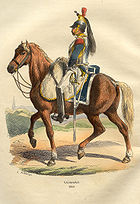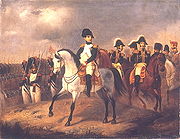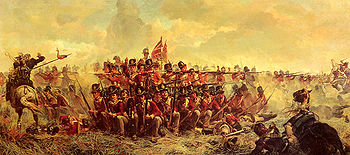
Horses in the Napoleonic Wars
Encyclopedia

Napoleonic Wars
The Napoleonic Wars were a series of wars declared against Napoleon's French Empire by opposing coalitions that ran from 1803 to 1815. As a continuation of the wars sparked by the French Revolution of 1789, they revolutionised European armies and played out on an unprecedented scale, mainly due to...
for combat, patrol and reconnaissance, and for logistical support. Vast numbers were used throughout the wars. During the War of the Sixth Coalition
War of the Sixth Coalition
In the War of the Sixth Coalition , a coalition of Austria, Prussia, Russia, the United Kingdom, Portugal, Sweden, Spain and a number of German States finally defeated France and drove Napoleon Bonaparte into exile on Elba. After Napoleon's disastrous invasion of Russia, the continental powers...
, depletion of the French cavalry arm through attrition (mainly suffered during the Russian Campaign
French invasion of Russia
The French invasion of Russia of 1812 was a turning point in the Napoleonic Wars. It reduced the French and allied invasion forces to a tiny fraction of their initial strength and triggered a major shift in European politics as it dramatically weakened French hegemony in Europe...
) and loss of horse-producing allies to provide remounts contributed significantly to the gradual French defeat and downfall of the French Empire
First French Empire
The First French Empire , also known as the Greater French Empire or Napoleonic Empire, was the empire of Napoleon I of France...
. During the Waterloo Campaign, the Armee du Nord had 47,000 horses: 25,000 cavalry, 12,000 for artillery, 10,000 for infantry and supply columns.
Cavalry

Heavy cavalry
Heavy cavalry is a class of cavalry whose primary role was to engage in direct combat with enemy forces . Although their equipment differed greatly depending on the region and historical period, they were generally mounted on large powerful horses, and were often equipped with some form of scale,...
and light cavalry
Light cavalry
Light cavalry refers to lightly armed and lightly armored troops mounted on horses, as opposed to heavy cavalry, where the riders are heavily armored...
reduced during the modern period and by the end of the Peninsular War
Peninsular War
The Peninsular War was a war between France and the allied powers of Spain, the United Kingdom, and Portugal for control of the Iberian Peninsula during the Napoleonic Wars. The war began when French and Spanish armies crossed Spain and invaded Portugal in 1807. Then, in 1808, France turned on its...
, heavy cavalry were performing the scouting and outpost duties previously undertaken by light cavalry.
On the battlefield, the cavalry
Cavalry
Cavalry or horsemen were soldiers or warriors who fought mounted on horseback. Cavalry were historically the third oldest and the most mobile of the combat arms...
's main offensive role was as shock troops, providing a mounted charge. Charges were carefully managed for speed (a charge's maximum speed was 20 km/h (12.4 mph); faster progress resulted in a break in formation, and blown horses) and formation, and undertaken across clear rising ground, the cavalry deploying in line or column, and often accompanied by horse artillery. Frequently, infantry followed behind, in order to secure any ground won. Once an enemy army had quit the field of battle and was on the retreat, cavalry would invariably be utilized in pursuit to further exploit a beaten foe's withdrawal and harass that army's rearguard
Rearguard
Rearguard may refer to:* A military detachment protecting the rear of a larger military formation, especially when retreating from a pursuing enemy force. * Rear Guard , a computer game released in 1982...
. In defence, cavalry could be used to attack and harass the enemy's infantry flanks as they advanced. In addition, cavalry were used to break up enemy lines following successful infantry action.

Line (formation)
The line formation is a standard tactical formation which has been used in Early modern warfare.It continues the phalanx formation or shield wall of infantry armed with polearms in use during antiquity and the Middle Ages....
or column
Column (formation)
A military column is a formation of soldiers marching together in one or more files in which the file is significantly longer than the width of ranks in the formation...
. A battalion formed in line was particularly vulnerable to cavalry, and could be broken or destroyed by a well-formed cavalry charge, such as when Lt-Col Colborne's
John Colborne, 1st Baron Seaton
Field Marshal John Colborne, 1st Baron Seaton, GCB, GCMG, GCH, PC was a British field marshal and colonial governor.-Early service:...
brigade was destroyed during the Battle of Albuera
Battle of Albuera
The Battle of Albuera was an indecisive battle during the Peninsular War. A mixed British, Spanish and Portuguese corps engaged elements of the French Armée du Midi at the small Spanish village of Albuera, about 20 kilometres south of the frontier fortress-town of Badajoz, Spain.From...
in 1811, with the loss of 1,250 out of his 1,650 men.
For protection, infantry sought their own cavalry screens and support. Otherwise, the infantry's only defence was to form square
Infantry square
An infantry square is a combat formation an infantry unit forms in close order when threatened with cavalry attack.-Very early history:The formation was described by Plutarch and used by the Romans, and was developed from an earlier circular formation...
: a tight four-sided formation, presenting walls of muskets and bayonets, each side protecting the others' flanks. These were generally impenetrable to cavalry, but vulnerable to artillery or other infantry. Cavalry were frequently used prior to an infantry assault, so that their charges might force an infantry line to break and reform, into formations vulnerable to infantry or artillery. During these manoeuvres, they remained especially vulnerable to cavalry.
Artillery
Another major use of horses throughout the period was as draught animals for the heavy artillery.In addition to field artillery
Field artillery
Field artillery is a category of mobile artillery used to support armies in the field. These weapons are specialized for mobility, tactical proficiency, long range, short range and extremely long range target engagement....
, where horse-drawn guns were attended by gunners on foot, the armies generally had horse batteries
Horse artillery
Horse artillery was a type of light, fast-moving and fast-firing artillery which provided highly mobile fire support to European and American armies from the 17th to the early 20th century...
, where each of the gunners were provided with mounts. Horse artillery generally used lighter pieces, although the British had some 9-pounder (medium-weight) horse batteries; for added speed, these had a team of 8 horses to pull them, rather than 6. In addition, horse artillery ammunition wagons were harnessed with an extra pair (6 horse instead of 4). Heavy artillery pieces needed a team of 12 horses, while Congreve rockets required about 25 horses. With the horses required for officers, surgeons and other support staff, as well as those pulling guns and wagons, each British artillery battery (6 guns) required 160–200 horses.
Horse artillery was generally used to support the cavalry units, and so came under the command of cavalry divisions, but in some battles, such as at Waterloo
Battle of Waterloo
The Battle of Waterloo was fought on Sunday 18 June 1815 near Waterloo in present-day Belgium, then part of the United Kingdom of the Netherlands...
, the horse artillery were used by the British as a rapid response force, successfully repulsing attacks from the French, and assisting the infantry recapture of La Haye Sainte
La Haye Sainte
La Haye Sainte is a walled farmhouse compound at the foot of an escarpment on the Charleroi-Brussels road. It has changed very little since it played a very important part in the battle of Waterloo on June 18, 1815...
from the French.
Horse types and breeds
The war horse was traditionally of moderate size for both officers and troopers, since heavy horses were logistically difficult to maintain, and less adaptable to varied terrains. Most armies at the time preferred cavalry horses to be 15.2 hh and 450–500kg, although cuirassiersCuirassier
Cuirassiers were mounted cavalry soldiers equipped with armour and firearms, first appearing in late 15th-century Europe. They were the successors of the medieval armoured knights...
frequently had heavier horses. Napoleon's Imperial Guard
Imperial Guard
The Imperial Guard was originally a small group of elite soldiers of the French Army under the direct command of Napoleon I, but grew considerably over time. It acted as his bodyguard and tactical reserve, and he was careful of its use in battle...
dragoons' mounts had an average size of 15hh. Lighter horses were restricted to scouting and raiding. Cavalry horses were generally obtained at 5 years, from 10 or 12 years service (barring loss) could be expected. Mares and geldings were used in preference to the less-easily managed stallions. Losses of 30–40% were common during a campaign, due to conditions of the march as well as enemy action.
As regimental structures developed, many units selected horses of uniform type, some, such as the Royal Scots Greys even specifying colour. Trumpeters, too, often rode distinctive horses, so they might stand out. Regional armies developed preferences, such as the British 15 hh hunters, the Germans' hanoverians
Hanoverian (horse)
A Hanoverian is a warmblood horse originating in Germany, which is often seen in the Olympic Games and other competitive English riding styles, and have won gold medals in all three equestrian Olympic competitions. It is one of the oldest, most numerous, and most successful of the warmbloods...
, and the Cossacks' steppe ponies, but the low supplies available in wartime resulted in horses of all types being used.

